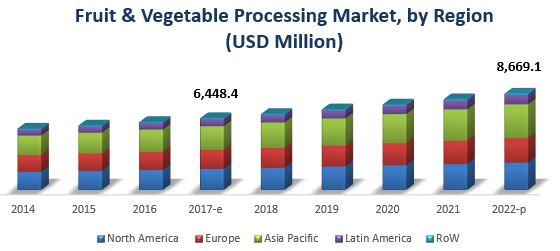Growth Opportunities in the Fruit & vegetable Processing Enzymes Market
The fruit & vegetable processing enzymes market, in terms of value, is projected to reach around USD 41.39 Billion by 2022, at a CAGR of 6.7% from 2016 to 2022. The market is driven by factors such as improved quality and yield for fruit & vegetable juices and beverages, high demand for convenience foods, increasing awareness for healthy foods, and high specificity of enzymes in biochemical reactions. The high growth potential in the emerging markets and untapped regions provides new growth opportunities for market players.

Download PDF Brochure: https://www.marketsandmarkets.com/pdfdownloadNew.asp?id=253649892
The global market based on sources has been segmented into bacteria and fungi. This is because bacteria is largely used to increase the shelf-life of fruits & vegetables for a prolonged time. Moreover, bacteria contributes to the easy genetic transformation for enzyme, which has led to the dominance of bacteria compared to other microorganisms in the fruit & vegetable processing enzymes market.
The global market, based on type, has been segmented into amylase, pectinase, protease, and cellulase. The amylase segment accounted for the largest share of the fruit & vegetable processing enzymes market in 2015. Amylases are mainly used in industries, such as food & beverages due to its cost effectiveness, and less time-consuming methods, and therefore the demand is high. Microorganisms are considered as the best source of these enzymes. Alpha-amylase, beta-amylase, and gluco-amylase are the major types of amylases. Out of the three types, á-amylase and gluco-amylase are used in a wider range of products in the food & beverage industry.
In the form segment, the market has been segmented on the basis of liquid and powder. The liquid form accounted for the largest share in 2015. The liquid enzyme is used directly in its liquid form or sprayed and absorbed onto a solid carrier. The liquid formulation of enzyme is supplied as a liquid solution, which is sprayed on the pellets. The growth in this segment is attributed to three major components, such as enzymatic, physical, and microbial stabilities are considered by manufacturers during the production stage which has resulted in the increased demand.
Speak to Analyst: https://www.marketsandmarkets.com/speaktoanalystNew.asp?id=253649892
The Asia-Pacific region is expected to surpass Europe as the second-largest consumer of fruit & vegetable processing enzymes. This is due to the rising demand from India and China, which has contributed to the industrial growth for food & beverages. More than two-thirds of the fruit & vegetable processing enzymes market in the Asia-Pacific region is import-dominated. Therefore, enzyme manufacturers have investment opportunities in new product developments across the Asia-Pacific region.
This report includes a study of marketing and development strategies, along with the product portfolio of leading companies. It includes the profiles of leading companies such as E. I. du Pont de Nemours and Company (U.S.), Associated British Foods Plc (U.K.), Koninklijke DSM N.V. (The Netherlands), Novozymes A/S (Denmark), and Group Soufflet (France).
